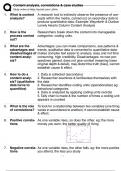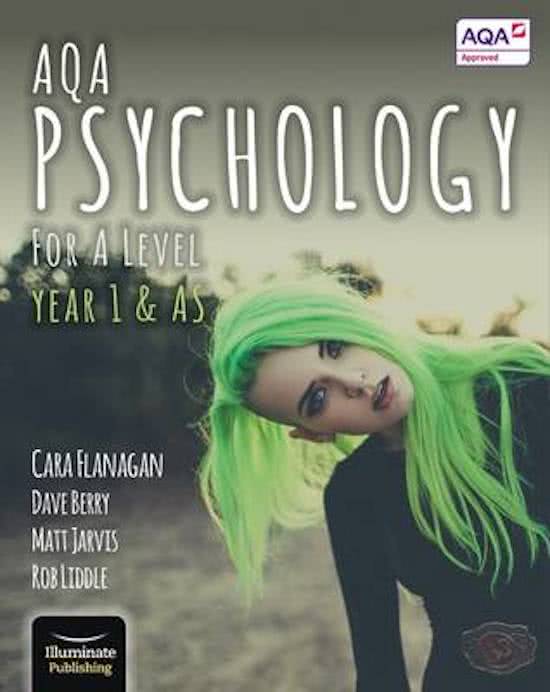Content analysis, correlations & case studies
Study online at https://quizlet.com/_atfnie
1. What is content A research tool to indirectly observe the presence of con-
analysis? cepts within the media, carried out on secondary data to
produce quantitative data. Example: Waynforth & Dunbar
Lonely Hearts Column Content Analysis
2. How is the Researchers break down the content into manageable
process carried categories- coding units.
out?
3. What are the Advantages: you can make comparisons, see patterns &
advantages and trends, qualitative data is converted to quantitative data-
disadvantages of makes complex text easier to analyze, easy and not time
content analy- consuming, high credibility. Disadvantages: no new per-
sis? spectives gained, does not give context (meaning loses
original depth & detail), may distort the truth (bias), cannot
establish cause & effect.
4. How to do a 1. Data is collected (secondary)
content analy- 2. Researcher examines & familiarizes themselves with
sis? (qualitative the data
data turns to 3. Researcher identifies coding units (operationalize) eg:
quantitive) behavioral categories
4. Data is analyzed by applying coding units (words)
5. Tally chart is made & the number of times a coding unit
appears is counted
5. What is the role To look for a relationship between two variables (one thing
of correlations? varies in accordance to another). It cannot establish cause
& effect.
6. Positive correla- As one variable rises, so does the other. eg: the more
tions money you earn, the better quality of living
7. Negative correla- As one variable rises, the other falls. eg: the more parties
tions you attend, the less you study
1/3
, Content analysis, correlations & case studies
Study online at https://quizlet.com/_atfnie
8. No correlation The two co-variables don't vary together at all. eg: cycle
test result & eye color
9. Correlation coef- Shows strength & direction of correlation. -1 is a strong
ficient negative correlation, around -0.5 is a moderate negative
correlation, between -0.5 and 0 is a weak negative corre-
lation, between 0 and +0.5 is a weak positive correlation,
around +0.5 is a moderate positive correlation and +1 is a
strong positive correlation.
10. What are case Case studies are in-depth studies of unique individuals.
studies? The data produced is qualitative data- detailed but difficult
to analyze. Case studies are ideographic (subjective). This
research method was used often by Sigmund Freud in the
psychodynamic approach.
11. How do case They use a range of different research methods, through
studies increase the process of triangulation
reliability (mak-
ing the investiga-
tion capable of
being repeated)?
12. What does trian- Triangulation includes interviews (structured, semi-struc-
gulation include? tured & unstructured), observations (covert/overt, par-
ticipant/non-participant, event/time sampling, naturalis-
tic/controlled) and past records (medical histories, diaries)
13. What are the Advantages: high validity- lots of detail & depth (qualita-
advantages and tive data), allow researchers to study events or complex
2/3





